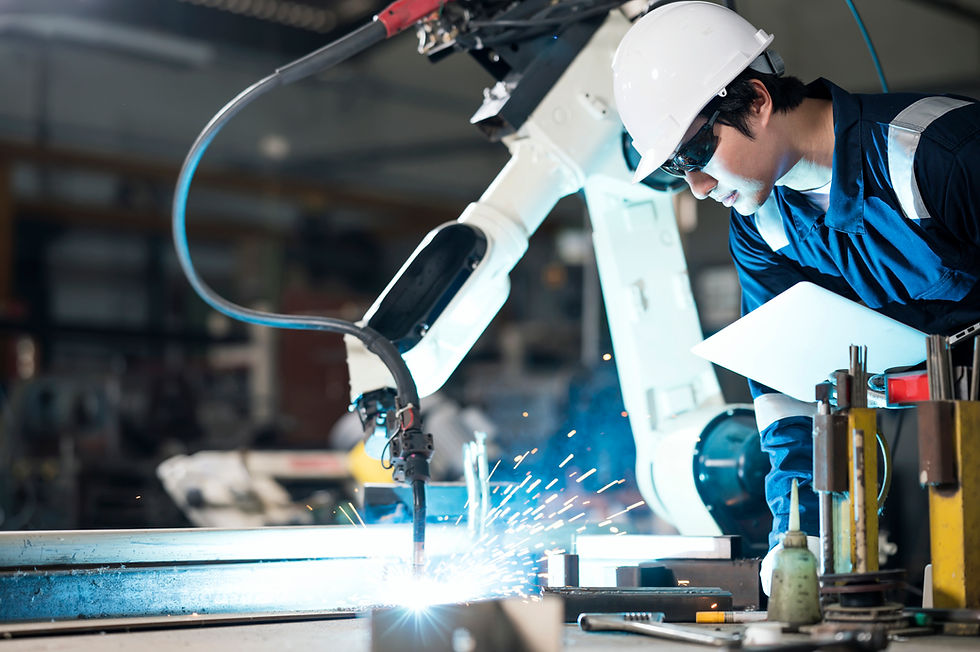Smart Factory Concepts
- Rajavarapu Maniteja
- Nov 12, 2024
- 4 min read

A smart factory leverages advanced technologies like IoT, AI, robotics, and big data to create a highly automated, interconnected, and flexible manufacturing environment. This next-generation manufacturing approach allows for real-time data monitoring, dynamic decision-making, and optimized production workflows, ultimately increasing efficiency, quality, and adaptability to changing demands.
Table of contents
Core Concepts of Smart Factories
Interconnectivity and IoT Integration: Smart factories use IoT devices to connect machines, sensors, and systems across the production floor. This connectivity enables seamless communication and data exchange, allowing machinery and systems to work collaboratively.
Real-Time Data Analytics: Continuous data collection and analysis help manufacturers monitor performance, detect anomalies, and make data-driven decisions. Real-time insights improve quality control, maintenance, and operational efficiency.
Automation and Robotics: Robotics and automation reduce the need for manual intervention, streamlining repetitive tasks and ensuring consistent output quality. Collaborative robots (cobots) work alongside human operators to enhance productivity and safety.
Artificial Intelligence and Machine Learning: AI-powered systems enable predictive maintenance, demand forecasting, and dynamic process adjustments. Machine learning algorithms analyze historical data to identify patterns and optimize processes.
Digital Twin Technology: Digital twins are virtual replicas of physical assets (machines, production lines, etc.) used for simulation, monitoring, and optimization. These models allow for testing and tweaking without affecting real-world operations, making it easier to enhance efficiency and troubleshoot issues.
Cybersecurity: As connectivity increases, smart factories require robust cybersecurity to protect critical data, systems, and machinery from unauthorized access, tampering, or cyber threats.
Edge Computing: Edge computing processes data closer to the source (e.g., sensors, machines), reducing latency and enhancing real-time decision-making. This is especially beneficial for time-sensitive applications such as quality checks or automated adjustments.
Predictive and Preventive Maintenance: By analyzing machine data, smart factories can predict when equipment might fail and schedule maintenance before issues arise, minimizing downtime and extending the lifespan of machinery.
Flexible and Modular Production Lines: Smart factories employ flexible and reconfigurable production setups, allowing them to quickly switch between products or adapt to changes in demand with minimal downtime.
Sustainability and Energy Management: Energy-efficient equipment, renewable energy integration, and waste minimization strategies make smart factories more sustainable. Real-time monitoring helps optimize energy usage and reduce environmental impact.
Key Technologies in Smart Factories
Industrial IoT (IIoT): Integrates sensors, machinery, and analytics platforms to connect and manage all factory components.
Big Data and Analytics: Uses large-scale data analysis to understand patterns, identify inefficiencies, and make improvements.
Machine Learning and AI: Supports predictive maintenance, defect detection, and process optimization based on historical data.
Robotics and Automation: Automates tasks, from assembly to quality control, improving consistency and throughput.
Cloud Computing: Centralizes data storage and processing, allowing global access to production data and facilitating collaboration.
Augmented Reality (AR) and Virtual Reality (VR): Supports training, remote assistance, and complex assembly tasks by overlaying digital information on physical objects.
Benefits of Smart Factories
Increased Efficiency: Automated processes and real-time analytics help reduce production time, resource use, and waste, leading to a leaner operation.
Enhanced Product Quality: Real-time monitoring, AI-based quality checks, and consistent production processes reduce defects and ensure high-quality output.
Reduced Downtime: Predictive maintenance and immediate fault detection minimize machine downtime, keeping production on schedule.
Greater Flexibility: Modular and reconfigurable production lines allow for quick adaptation to changing market demands, reducing lead times.
Improved Decision-Making: Data-driven insights empower managers to make informed decisions about resource allocation, scheduling, and process improvements.
Enhanced Safety: Automation, collaborative robots, and real-time monitoring reduce the risks associated with human error and improve worker safety.
Sustainability: Optimized energy consumption, reduced waste, and eco-friendly practices contribute to a smaller environmental footprint.
Applications of Smart Factories
Automotive Manufacturing: Automated assembly lines and real-time defect detection improve precision and speed, while AI optimizes production schedules based on demand.
Electronics Manufacturing: High-speed robotics and predictive maintenance help meet high-volume, high-precision requirements, reducing defects and improving output quality.
Food and Beverage Production: Real-time monitoring of temperature, humidity, and cleanliness ensures product quality and regulatory compliance.
Pharmaceutical Production: Strict quality control and real-time monitoring of production environments reduce risks of contamination and ensure compliance with health regulations.
Textiles and Apparel: Automated quality inspection and flexible production lines enable rapid adaptation to trends and optimize fabric use, reducing waste.
Challenges in Implementing Smart Factories
High Initial Investment: Implementing IoT devices, robotics, and data systems requires substantial upfront costs.
Integration with Legacy Systems: Integrating new technologies with older equipment and systems can be complex and costly.
Data Security and Privacy: Increased connectivity brings cybersecurity challenges, making it essential to protect sensitive production data and prevent cyberattacks.
Skill Gaps: The transition to smart factories requires workers skilled in data analysis, IoT, and cybersecurity, creating a need for reskilling and training.
System Complexity: Managing and optimizing interconnected systems can be challenging, especially in large facilities with diverse production lines.
Future Trends in Smart Factories
AI-Driven Autonomous Production: Enhanced machine learning will support more autonomous decision-making, reducing the need for human intervention.
5G Connectivity: The rollout of 5G networks will enable faster, more reliable data transmission, improving real-time analytics and robotics.
Sustainable Manufacturing: Increased focus on sustainability will drive the adoption of eco-friendly practices, waste reduction technologies, and energy-efficient machinery.
Digital Twin Advancements: More advanced digital twins will enable complex simulations and process optimizations, helping manufacturers refine designs before physical implementation.
Collaborative Robotics: Robots with advanced AI and safety features will work even more seamlessly with human operators, improving flexibility and safety in shared workspaces.
Conclusion
Smart factory concepts represent the pinnacle of modern manufacturing, creating an ecosystem where data and automation enhance productivity, quality, and sustainability. The journey toward fully autonomous, responsive factories is well underway, driving innovation and transforming the industrial landscape.


תגובות